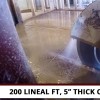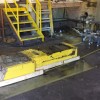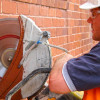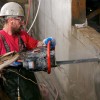GPR Concrete Scanning
Ground Penetrating Radar (GPR) can be used for several things, including but not limited to:
- Inspecting for reinforcement in the floor, wall, or ceiling
- Locating conduit, pipe, rebar reinforcement, pre- and post-tension cables, voids, etc.
- Verifying the actual construction conforms to spec. An example being if rebar was to be installed in a block wall during construction
JEM Ground Penetrating Radar provides a non-destructive way to “see” into the concrete or masonry and locate many hidden objects. Unlike X-ray, it does not require any work stoppage or cordoning off of work areas.
JEM GPR can scan concrete up to 24″ thick. Even thicker concrete can be scanned if access from both sides of the slab is available.
JEM GPR utilizes the highest quality equipment to locate embedments in the concrete, and our trained technicians will mark the locations out for you. GPR makes jobsites safer by reducing the likelihood of hitting utilities that can injure workers or slow progress on a project due to unexpected repairs. Contact us today for a quote.
What can’t Ground Penetrating Radar (GPR) do?
While GPR is a tremendously useful and flexible resource, there are a few things it cannot do:
- Scan in concrete with a high moisture content. For example: a fresh pour or concrete that has been rained on recently.
- Scanning deeper than 24″. However, if there is access to both sides of the slab JEM GPR can scan up to 24″ from each side.
- Differentiate between objects located in the concrete. GPR is a great tool for telling the operator there is something in the concrete, it just isn’t very good at telling the operator what the object is. Rebar, conduit, wire mesh, and many other embedments look very much alike on a scan. Sometimes an operator is able to make an educated assumption of what the object is based on experience or patterns in the embedment.




